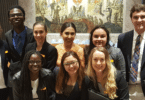While Black History Month only lasts through February, there’s no time limit on learning more about Black art, history, and activism. In our list of top-rated courses, you’ll learn about nonviolence, inclusive leadership and diversity, anti-racism and designing anti-racist spaces, racial health inequity, and more. Whether you work in activism, DEI, healthcare, human rights, design, or you simply want to continue your education, these courses help you build your knowledge base and engage with valuable material through readings, videos, reflection questions, and graded assignments. Courses can be audited for free, but if you want a certificate that proves course completion, you’ll need to pay a fee. If you want to earn certificates for all or a handful of these courses, it might be worth paying for Coursera Plus, a subscription that opens access to over 90% of the site’s courses.
Table of Contents
#1. Narratives of Nonviolence in the American Civil Rights Movement (Emory University)
#2. Inclusive Leadership: The Power of Workplace Diversity (University of Colorado)
#3. Anti-Racism I (University of Colorado Boulder)
#4. Anti-Racism II (University of Colorado Boulder)
#5. Race and Cultural Diversity in American Life and History (University of Illinois at Urbana-Champaign)
#6. Addressing Racial Health Inequity in Healthcare (University of Michigan)
#7. Designing and Building Institutional Anti-Racist Spaces (Wesleyan University)
#8. Reimagining Blackness and Architecture (MoMA)
#9. Community Awareness: Police Brutality in the U.S. (University of Michigan)
#10. Take Action: From Protest to Policy (Wesleyan)
#1. From Freedom Rides to Ferguson: Narratives of Nonviolence in the American Civil Rights Movement (Emory University)
Course description – The Civil Rights Movement challenged the United States to extend democratic principles to African Americans and all people. What kind of strategic planning went into this movement? This course examines the history of the campaigns, the different groups and coalitions involved, the philosophies and methods of nonviolent direct action, and the contemporary application of nonviolent conflict transformation. Dr. Bernard LaFayette, Jr. who was involved in the Civil Rights Movement’s organization, leads the course. Guest speakers include Constance Curry, Andrew Young, and Reverend C.T. Vivian.
What you will learn (excerpt)
- Understand the chronology and phases of the Movement and Civil Rights campaigns
- Analyze the importance of organizing groups and strategy
- Identify the six strategies of nonviolence
- Assess the future of nonviolence
How you will learn
This self-paced course is divided into five weeks and takes about 15 hours to complete. Coursework consists of videos, readings, discussion questions, practice exercises, and a 30-minute quiz at the end of each week. To earn your certificate, you’ll need to earn a passing grade (80% or higher) on each graded assignment. The quizzes are each worth 25% of your grade. At the time of writing, the course had a 4.8/5 user rating.
#2. Inclusive Leadership: The Power of Workplace Diversity (University of Colorado)
Course description – Employees value diverse and inclusive workplaces. To create environments that are safe and supportive of everyone, leaders need to understand diversity and inclusion. This course guides aspiring leaders on how to develop inclusive workplace cultures no matter what type of workplace they’re in. Dr. Brenda J. Allen, a retired Chief Diversity Officer and renowned educator in inclusion, racial equity, and strategic leadership, teaches the course.
What you will learn (excerpt)
- Understand why inclusion and inclusive leadership matter
- Identify the six traits of highly-inclusive leaders
- Describe communication practices related to the six traits
- Develop strategies for applying what you’ve learned in a workplace
How you will learn
The course is divided into four weeks and takes 22 hours total to complete. Coursework includes videos, readings, practice exercises, and a quiz at the end of each module. Each quiz is worth 25% of your grade. Three take 45 minutes while one takes an hour. You must receive a score of 80% or higher to pass. You can see the quizzes with the audit track but must upgrade to the paid track to submit and receive a grade. At the time of writing, the course had a 4.9/5 user rating.
#3. Anti-Racism I (University of Colorado Boulder)
Course description – This beginner’s course introduces students to race and racism in the United States. It’s a good fit whether a student is completely unfamiliar with the topic or only has a basic understanding. The course explores concepts like “whiteness,” white privilege, systemic and institutional racism, and more. The course is taught by Shawn O’Neil, a musician and race scholar in the department of ethnic studies, and Jennifer Ho, the director of the Center for Humanities & The Arts at the University of Colorado Boulder and a Professor of Ethnic Studies.
What you will learn (excerpt)
- Define race through definitions of whiteness
- Identify the impact of race, racism, and anti-racism
- Understand the historic context for systemic racism
- Apply the terms and concepts you’ve learned
How you will learn
“Anti-Racism I” is divided into three weeks of study and takes about 16 hours total. Coursework consists of videos, readings, a quiz, and a peer-graded assignment. The quiz, which is on anti-racism glossary terms, is worth 25% of your grade. To pass, you need an 80% or higher. The peer-graded assignment (you will also need to review three of your peers’ work) is worth 75% of your grade. To submit these assignments and receive a grade, you’ll need to take the paid track of the course. At the time of writing, this course had a 4.6/5 user rating.
#4. Anti-Racism II (University of Colorado Boulder)
Course description – This course builds off “Anti-Racism I,” so it’s designed for students who have completed that course or who already have a basic knowledge of racial issues in the United States and globally. “Anti-Racism II” guides students on how to have deeper conversations about race, as well as gender and sexuality. Students will be equipped to engage with and discuss complex topics such as toxic masculinity and intersectionality. Like “Anti-Racism I,” Shawn O’Neil (musician and scholar in ethnic studies) and Jennifer Ho (Professor of Ethnic Studies) teach the course.
What you will learn (excerpt)
- Understand settler colonialism, race and racism, and hyper/toxic masculinity
- Recognize the costs of racism
- Explore linguistic constructions of race and racism
- Understand and analyze the concept of intersectionality
- Practice how to have conversations about race and racism
How you will learn
“Anti-Racism II” is divided into four weeks and takes about 20 hours total to complete. Coursework consists of videos, readings, discussion prompts, and two graded assignments. The first assignment – a discussion prompt assignment – is worth 25% of your grade. The final project – a recorded interview about race and racism – is worth 75% of your grade. You will need to review three of your peers’ assignments, as well. To access grading and a certificate upon completion, you’ll need to take the paid course track. At the time of writing, “Anti-Racism II” had a 4.8/5 user rating.
#5. Race and Cultural Diversity in American Life and History (University of Illinois at Urbana-Champaign)
Course description – This course leads students into a deeper understanding and appreciation of how race, ethnicity, and cultural diversity have shaped American institutions, ideology, law, and social relationships. This course focuses on the historical and social relationships among European Americans, Native Americans, African Americans, Latino/as, and Asian/Pacific Americans. Race and ethnicity are treated as dynamic and complex ideological and cultural processes. James D. Anderson, who is the Edward William and Jane Marr Gutsgell Professor and Interim Dean of the College of Education at the University of Illinois at Urbana, teaches the course.
What you will learn (excerpt)
- Understand the concept of “race” and its use in the United States
- Explore the historical legacies of race in the US
- Understand how race is lived today
- Investigate institutional racism, systemic social inequalities, and discrimination patterns
How you will learn
This course is divided into four weeks and takes about 8 hours total to complete. Coursework includes videos, readings, and four peer-graded assignments. There’s a self-reflection assignment (15% of your grade), an annotated resource listing (10%), a research project proposal (25%), and a full research paper (50%). You must also review three of your peers’ assignments to pass. At the time of writing, this course had a 4.6/5 user rating.
#6. Addressing Racial Health Inequity in Healthcare (University of Michigan)
Course description – Through the years, racial inequities in healthcare have become increasingly more recognized. Significant gaps in understanding and action remain, however. This specialization provides students with the history and sociological contributions causing racial inequities in healthcare (course 1). Students are also taught how to critically analyze the causes of racial inequities (course 2) and how to achieve equity (course 3). Dr. Minal R. Patel, an Associate Professor in the Department of Health Behavior & Health Education, teaches the specialization.
What you will learn (excerpt)
- Recognize the history that created disproportionate disease burdens within racial/ethnic groups
- Understand what causes ethnic and racial disparities in health status and outcomes
- Analyze approaches to achieving racial equity such as community health centers and reparations
- Understand the similarities between the lack of healthcare access/representation and other sectors in the US and globally
How you will learn
The entire specialization takes about four months to complete with four hours of work per week. Coursework includes videos, readings, practice exercises, and one peer-reviewed assignment in week 3 of each course. In the first course, students create a “health profile” of a selected country, U.S. state, city, or town. In the second course, students choose a country or U.S. state and create a “healthcare structure profile.” In the last course, students select a country or U.S. state and create an intervention to address a specific racial/ethnic disparity.
#7. Designing and Building Institutional Anti-Racist Spaces (Wesleyan University)
Course description – The goal of this course is to teach students the tenets of equity, anti-racism, and cultural justice. Students are also taught how to apply these ideas in pursuit of social change, as well as how to explore creative approaches to social justice, racial justice, and advocacy. Educators, administrators in education, lawyers, and advocates working in equity and civil rights will all benefit from this course. Jonathan Andrew Perez, a visiting lecturer, teaches.
What you will learn (excerpt)
- Understand implicit bias, prejudice, racism, equity, equality, and other essential concepts
- Apply design thinking for equity and justice
- Examine shifting narratives of looting, rioting, and protesting
- Analyze your institution and identify what needs to change and how to change it
How you will learn
The course is divided into four weeks and takes about 21 hours total to complete. Coursework consists of videos, readings, practice quizzes, discussion prompts, and two peer-graded assignments. Both assignments (which are each worth 50% of your grade) are two short essays. You must also review three of your peers’ essays to complete the course. At the time of writing, there were no user reviews yet.
#8. Reimagining Blackness and Architecture (MoMA)
Course description – This course looks at the relationship between architecture and Blackness as both an identity and a lived experience. It’s structured around five themes: Imagination, Care, Knowledge, Refusal, and Liberation. Black artists, architects, scholars, and writers will discuss how they reimagine their surroundings and how Black makers have changed the world. Arlette Hernandez, a Volkswagon Fellow for Digital Learning, and Sean Anderson, an Associate Curator, teach the course.
What you will learn (excerpt)
- Understand key terms and concepts surrounding architecture and Blackness
- Recognize how race and racism impact architecture and the built environment
- Explore the work of Black architects, artists, and other makers
- Examine the role individuals play in building a just and equitable world
How you will learn
This beginner course is divided into six weeks and takes about 14 hours to complete. Coursework consists of videos, readings, and six quizzes at the end of each module. The first quiz is worth 10% of your grade while the others are worth 18%. To submit your answers and receive a grade, you’ll need to take the paid course track. A passing quiz grade is 80% or higher. At the time of writing, the course had a 4.9/5 user rating.
#9. Community Awareness: Police Brutality in the U.S. (University of Michigan)
Course description – In 2020, the United States experienced a historic burst of protests against police brutality. This free course digs into the context behind the protests, including the history of police violence, the laws and policies that derail accountability, the demands of protesters, and the knowledge and tools that can spark change. This course is adapted from a Teach-Out launched in July 2020. It’s led by Teach-Out Experts involved in social work, government, law, higher education, and activism.
What you will learn (excerpt)
- Understand the history of modern policing in the U.S.
- Examine how police violence affects individuals and communities
- Explore the practices of modern policing and why they make accountability so challenging
- Recognize the various ways individuals and communities respond to police violence
- Develop an action plan on how to apply what you’ve learned in your community
How you will learn
This course is divided into five weeks and takes around 17 hours total to complete. Coursework consists of videos, readings, and discussion prompts. There are no graded assignments. Because there is no paid track or certificate for this course, all materials – including the discussion forums – are accessible to anyone who signs up. At the time of writing, “Community Awareness” didn’t have a user rating yet.
#10. Take Action: From Protest To Policy (Wesleyan University)
Course description – This beginner’s course introduces students to four strategies for transforming activist work into policy change. First, how to use the courts to raise awareness, gain information, mobilize, and change the law. Next, how to analyze the benefits of communication across platforms. Third, how to connect power through stakeholder analysis and issue framing. Lastly, students study the benefits of local work. By the course’s end, students will know how to create a comprehensive plan for real-world change. Sarah Ryan (Associate Professor in Information Science) and Mary Alice Haddad (John E. Andrus Professor of Government; Professor, East Asian Studies; Professor, College of the Environment) teach the course.
What you will learn (excerpt)
- Understand how courts can be used to change policy
- Recognize how communication platforms can reach diverse audiences
- Identify stakeholders and how to frame issues to get support
- Apply what you’ve learned to a local context
- Create a plan to turn a specific issue from protest into policy
How you will learn
This beginner course is divided into six weeks and takes about 34 hours total to complete. Coursework includes videos, readings, quizzes, and peer-graded assignments. These assignments include questions about a court hearing; a compare-and-contrast exercise; creating a stakeholder chart; and completing a final paper (worth 20% of your final grade) on a plan for policy change. For the peer-graded assignments, you must also provide feedback to three of your peers. At the time of writing, there were no user ratings for this course yet.












